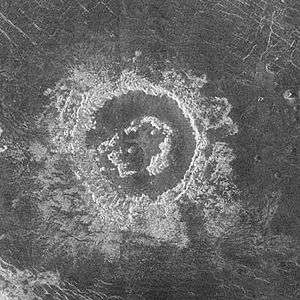Peak ring (crater)

A peak ring crater is a type of complex crater. A central peak is not seen, instead, a roughly circular peak (possibly discontinuous) surrounds the crater's center.
How they form
Peak rings have long been viewed to form in the stage subsequent to central peak formation in craters. The central peaks of craters are believed to originate from hydrodynamic flow of material lifted by inward-collapsing crater walls, while impact-shattered rock debris is briefly turned to fluid by strong vibrations that develop during crater formation. The peak-ring structure of Chicxulub crater was probably formed as inward-collapsing material impacted the over-steepened central peak, to form a hydraulic jump at the location where the peak ring was located.[1]
Other theories have been formulated. Perhaps, in the case of Chicxulub crater, an over-high central peak collapsed into the peak ring.[2]
Notably, Chicxulub crater is the only peak ring currently visible on Earth.[3]

More ideas are available.[3]
See also
- Barton (crater)
- Chesapeake Bay impact crater
- Chicxulub crater
- Complex crater
- Eminescu (crater)
- Mozart (crater)
- Polygnotus (crater)
- Rachmaninoff (crater)
- Raditladi Basin
- Renoir (crater)
- Schrödinger (crater)
References
- ↑ H. J. Melosh (2015). "PEAK-RING CRATERS AND MULTIRING BASINS" (PDF). Retrieved 18 Nov 2016.
- ↑ H. J. Melosh. "Drilling into Chicxulub's formation". Retrieved 18 Nov 2016.
- 1 2 Thomas Sumner (Nov 17, 2016). "How a ring of mountains forms inside a crater". Retrieved 18 Nov 2016.
External links and references
- A Springer link
- Another link
- A reference on Venus
- On the dinosaur-killing crater
- More on their formation